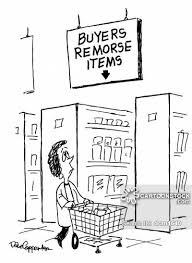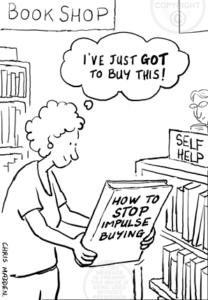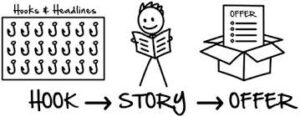As marketers and salespeople, it’s important to understand how to eliminate buyer’s remorse if we want to sell more. We are always trying to promote our products and services and present them in the best light possible.
We want our customers to feel good about spending their money with us, and we want our products and services to offer them tremendous amounts of value compared to the cash value they have paid for it. The better our customers feel when they buy from us, the more likely they are to remain a customer and also to recommend us to people they know.
This is why it’s so important to make sure our customers are fully satisfied with their purchases and have no doubts or regrets about buying from us. These negative feelings that customers sometimes feel after they have made a purchase is commonly known as “Buyers Remorse.”
This article examines what buyers remorse is, what causes it, and what we as marketers can do to reduce or completely eradicate it, hopefully leading to making more sales and turning our customers into raving fans.
What Is Buyers Remorse?
We’ve all been there. At some point in our lives we’ve spent months and months thinking about buying that product we so desperately want.
We’ve gone online and read all the reviews, watched countless YouTube review videos, and spoken to people who have used the same product. We’ve scoured the internet for the cheapest prices and best deals, and we finally arrive at the point where we have all the information, cash, and courage to make the purchase.
Woo Hoo! We’ve reached the point of making a buying decision and we’re ready to go through with the sale. We complete the sale, hand over the cash, grab our goodies, and hurry home excited about what we’ve just brought.
Having finally gone through with the sale and are now feeling a sense of relief, self-satisfaction, and excitement. Oh how much better our life is going to be with our shiny new toy!
Then we get home, and doubt and fear set in… We start to question our decision, and all sorts of questions race through our minds: Have I made the right decision? What if the product doesn’t meet my expectations? What if the product fails and the service offered by the company is not good enough to sort the issues out? What if I could have got it for cheaper elsewhere?

I have personally experienced these feelings countless times, and I’m sure you have too. What you are experiencing is commonly known as Buyers Remorse. Buyer’s Remorse is the feeling of regret, guilt, or fear that we experience when we’ve purchased a product or service, and then feel that we have made the wrong choice.
These feelings can make us have doubts about the price, quality, quantity, and how much we will use the product/service. The feelings of buyers remorse can vary from slight to extreme, and the level of intensity is normally affected by a few factors:
5 Factors That Influence Buyer Remorse Intensity
- The Price Of The Item Purchased
- The Number Of Alternative Options Available
- The Necessity Of The Purchase
- The Opportunity Cost
- Our Involvement In The Decision Making Process
Let’s look at each one individually.
1. The Price Of The Item Purchased
The higher the price, the higher the level of buyer’s remorse that may be experienced. Whenever we make a purchase decision our brains process this as act as a risk. What are we risking? We are risking making a mistake, and when we make mistakes we feel bad. Over time as we get older, we learn that we enjoy feeling good, and hate feeling bad.
We are hardwired to avoid doing things that make us feel bad and do more of the things that make us feel good. Makes sense, doesn’t it? When we make an expensive purchase we are putting ourselves at risk of making an expensive mistake which will generate feelings of guilt, regret, and anxiety.
We are hoping that the money we spend will be worth it in return for the amount of value we experience from the product in return. The more of our hard earned cash we spend on something, the more we expect from it, and in our minds, this means the bigger the risk we are taking.
In a behavioural science study, participants were shown a variety of images whilst the reaction in their brains were monitored. When images of prices were flashed on the screen, the part of the participant’s brains associated with pain was activated. This experiment was repeated several times and was shown to be conclusive – on an unconscious level, we link price to pain!
Expensive purchases are more likely to lead to more intense levels of buyer remorse, and less expensive purchases tend to lead to less intense feelings.
2. The Number Of Alternative Options Available
Having more options means we have to spend more time thinking about which product is right for us and which will best suit our needs.
This can make the decision making process stressful as we don’t want to make the wrong decision and pick the product that is inferior, is more expensive, and delivers less value for money.
Online reviews are really helpful in helping people to compare different products and make a reasonable decision, but the more products there are to compare, the more chances there are of making the wrong decision.
We eventually reach the point known as Decision Fatique. This is the point where every new product comparison and evaluation decision seems to get harder and harder as we just can’t seem to decide.
After carefully weighing up all our options we make a decision and go for product A. Then we start to think that maybe Product B should have been our choice, or in hindsight, Product C offered the best value for money. Once we have decided to go through with the purchase the other options may weigh on our mind and we start to doubt if we have made the right decision after all.
That’s why consumer psychologists have proven that if you narrow the number of options it actually makes it easier for consumers to make a purchase decision.
3. The Necessity Of The Purchase 
Is it is an essential purchase or an impulse purchase?
If we’ve just spent our hard earned cash on yet another luxury watch, or a designer pair of shoes that we don’t really need, then feelings of guilt and regret will tend to set in.
The excitement of making these sorts of purchases normally fades once the purchase is made. Then we start to think about the things that we really should have spent that money on, like perhaps paying those outstanding parking tickets, or enrolling in that training course we’ve been meaning to do.
The higher the level of necessity there is for making a purchase, the less remorse will be felt. The lower the level of necessity, the more remorse will be felt
4. The Opportunity Cost
When we part with our cash for a certain product we may start thinking about all the ways in which we could have spent that money. This can include completely non-related products, services, or experiences we could have spent our money on instead. In economics, this is known as an “Opportunity Cost”.
Once we arrive at a buying decision and go through with the purchase we tend to think of all the alternatives that we have given up as a result and this can cause feelings of doubt and anxiety.
5. Our Level Of Involvement In The Decision Making Process
How involved we are in the decision making process before making a purchase can vary from low to high levels of involvement.
Involvement refers to the amount of effort and cognitive processing required during the decision making stage, how important the product is to you, and how much information you need to make the decision.
Low involvement purchases are normally low cost items that we use regularly and don’t have to spend much time (if any) thinking about them or considering alternative brands. e.g. buying bread is a low involvement buying decision.
We know what brand we like and when the bread in our cupboard is running low we naturally make the decision to buy a new loaf the next time we are at the grocery store without thinking about it.
A high involvement decision involves a lot more thinking and consideration. An example would be the purchase of a house. When considering whether to buy a house we tend to make a lot of effort in finding out as much information as we can about the property, the neighbourhood, our potential new neighbours, the local amenities, the crime rate, the community etc.
We may speak to other people who live in the area, and look at reviews online. We will want to see as many different properties as possible and gather enough information to ensure that we are making an informed decision.
High involvement decisions represent taking a higher risk – making the wrong decision and moving into a house that has a lean against it, rot in the basement, and crazy neighbours would be a disaster and would significantly affect how we feel.
Low involvement decisions represent low risk – what’s the worst that can happen if you brought a loaf of Wonder Bread instead of your regular Warburtons?
Low-risk purchases = less intense feelings of buyers remorse.
High-risk purchases = more intense feelings of buyers remorse.
How To Reduce Buyer’s Remorse
Now that you have a bit more insight into Buyers Remorse and its causes, you can see how important it is to reduce it in order to keep customers satisfied, improve referral rates, and gain their trust and loyalty.
Here are some immediate action steps you can implement to reduce buyer remorse:
Offer a Money-Back Guarantee
This is a tried and tested method of gaining trust with customers. Offering a 100% money-back guarantee is proven to increase sales significantly. It automatically reduces the risk level involved in the purchase and makes the decision easier as the customer can try the product risk-free, knowing they can get their money back should they want to.
Offer Post-Purchase Customer Support
There may be a few niggling doubts and questions that your prospect has in the back of their minds once they have made the purchase.
Providing a way for them to be able to speak to you or someone from your customer support team (if you have one) will make them feel a lot more reassured and will reduce the amount of anxiety that could normally lead to refund requests.
Having a customer support phone number, live chat function, or email support is a great way to gain customer trust, and increase their confidence in your product and company.
Offer a Free Trial Period
Another great way to get prospects to use your products risk-free. Offering a 30-day free-trial is a sure way of getting people to sign-up and try your product or service.
Even if they cancel after the trial, you have their contact details and can re-market to them at a later date with other offers and trials.
Offer Extended Warranty and Repair or Replace Service
We all dread dropping our brand-new smartphones and cracking our screens, or turning on our new laptop to find it doesn’t work.
Offering a good warranty period it gives customers peace of mind knowing that if anything goes wrong they will get the support and service required to repair the item or get a brand new replacement.
This is great for expensive purchases such as laptops, smartphones or household appliances.
Show Post-Purchase Confirmation or Thank You Page
There have been a few occasions where I’ve brought something online and after I’ve typed in my credit card details and clicked the buy button, nothing happened! Not even a confirmation page or follow-up email to let me know my sale had gone through and was complete. I was left wondering if I needed to re-order, at the risk of making the purchase again and being charged twice…something I felt uneasy about doing.
This is a frustrating experience and creates feelings of regret and even animosity toward the company for having such a crummy after-sales process.
You should always have a confirmation message shown once a customer has purchased something. A thank-you page and email order confirmation are expected as the norm these days, and they provide closure of the sales process to the customer. Make sure you include these!
Use Coupons or Discount Codes
Make use of coupons or offer discount codes to give prospects more reasons to buy.
When customers feel like they’ve got a bargain the feelings of buyer’s remorse are naturally lessened, and they are able to feel good about their purchase.
Summary
When you take the steps mentioned above to reduce the unwanted feelings of buyer’s remorse in your customers, you gain their trust much more easily. Trust is one of the most important things that must be established before and after a sale is made.
Whether you are representing yourself as a salesperson, or consultant, or you are working for a large sales organisation, you will be able to attract more prospects, make more sales, and retain more customers when you are able to establish trust.
When you offer ways to reduce your prospect’s feeling of buyer’s remorse, their buying experience is pleasurable and not painful. This positive buying experience makes them trust you, and this can lead to them becoming loyal customers.
Whenever they think of your brand they won’t associate it with the pain or risk that consumers are so desperate to avoid. Instead, they’ll associate your brand, products, and services with positive feelings, and this is the key to retaining customers and getting repeat business and referrals.




